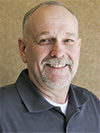My territory includes the upper two-thirds of Wisconsin, southeast and northeast Minnesota, and the Upper Peninsula of Michigan, which are heavy corn silage-growing areas.
That means I have the opportunity to educate growers, dealers and sales reps specifically about silage production and work closely with dairy producers who grow corn silage to feed their cows.
What I’m doing this time of year
Spring is an “all hands on deck” season, so I am willing to help when and where needed. Typically in March and April, I am a resource to help sales representatives and dealers get seed delivered in time for planting.
During this time, most seed has been purchased and growers are preparing for planting. I visit farms and answer questions about product placement, planting depths and fertility needs for specific corn hybrids so growers are ready when it is time to put seed in the ground.
An important task for me this time of year is planning for corn hybrid test plots. Nationwide, my company tests hybrids on more than one million test plots in 300 testing environments across 29 corn-growing states. We also work with universities and other third parties to compare our hybrids under real-world growing conditions.
For these plots to provide useful yield data at the end of the season, it is important to plant the right products for that area, taking geography and soil types into consideration. To support plots, I do anything from delivering seed to answering questions about hybrid selection and planting dates.
A glimpse at the rest of the year
After planting is completed, I spend most of my time in training, sales support, technical support and evaluating new products.
Two days of my job are never the same. My schedule for the day can change with a phone call. One day I might be talking with a dairy producer about planting BMR corn silage; the next, I might be helping a new sales rep better understand the disease-tolerance characteristics of our grain corn products.
Growers, dealers and sales reps depend on me for the most up-to-date agronomic information. Throughout the year, I hold meetings in my territory with sales reps and dealers to make sure they are up to speed on agronomic topics such as selecting the right type of silage hybrid or estimating corn maturity.
I train them on how to best represent our products to growers. The more information I can offer, the more they can help growers have a successful season.
Evaluating new products is an important part of my job, too. As new corn hybrids are developed, I help assess them to determine whether they are likely to be successful for growers in my territory.
I know my territory well and understand which maturities perform best and which disease-control and insect-control trait packages a hybrid should have.
Talking silage
When it comes to silage corn hybrids, I help growers understand the planting populations, fertility needs and harvest guidelines. There are unique considerations for growers using BMR corn silage hybrids, which are bred to be highly digestible to improve feed intake and help cows produce more milk.
One of the ways I help educate growers about corn silage is by participating in a biweekly radio segment for Today’s WAXX (104.5 FM), a station in central Wisconsin.
I work with Bob Bosold, the station’s agricultural broadcaster, to reach agronomists, nutritionists and dairy producers about growing corn silage hybrids.
During the segment, called “Silage Focus,” we discuss topics to help growers grow, harvest and feed corn silage more effectively, often in partnership with some of our dairy nutritionists.
A common topic is BMR corn silage, since many growers have questions about these types of corn hybrids. Listen to “Silage Focus” segments.
What I enjoy most
My mission is to help customers grow a successful crop. Fulfilling that goal can be challenging based on many factors, including geography, the crop and the grower.
I often work closely with sales reps and nutritionists to ensure dairy producers have expert support all year. This includes choosing the best hybrids for their specific needs and understanding ration formulation.
It’s very satisfying working with first-time growers of BMR corn silage hybrids. Research shows that when a grower chooses to grow and feed BMR corn silage, he or she can expect an average 4-pound to 5-pound increase of milk per cow.
The sales representative, herd nutritionist and customer agronomist work together to help the dairy producer achieve that goal. It’s a great success for our team when a grower follows our management and feeding recommendations and sees a response that equals or surpasses expectations.
Gaining the trust and appreciation of producers gives me a strong feeling of accomplishment. It’s what makes what I do so much fun.
At the end of the day, my goal is to be a reliable source of agronomic information to sales reps, dealers and growers. Whether I spend the day in the field looking at crops or providing silage training to a new member of our team, I enjoy being the person they rely on for sound agronomic advice about growing corn silage and other products. FG
Jon Erickson is a customer agronomist with Mycogen Seeds.

Jon Erickson
Customer Agronomist
Mycogen Seeds










